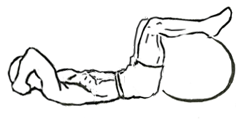Last Updated on September 25, 2014
When it comes to building stronger, more defined arms, the biceps curl is one of the most effective and popular exercises. While the traditional barbell or dumbbell curl often takes center stage in many strength training routines, the Standing Biceps Curl with Cable offers unique advantages that can take your arm training to the next level. By incorporating the cable machine into your biceps workout, you can add continuous tension to the muscles, which is key to muscle growth and strength development.
In this detailed guide, we’ll explore the benefits of the Standing Biceps Curl with Cable, provide a step-by-step breakdown of the exercise technique, highlight common mistakes to avoid, and offer variations to maximize the effectiveness of this biceps exercise.
What is a Standing Biceps Curl with Cable?
The Standing Biceps Curl with Cable is a variation of the traditional biceps curl that uses a cable pulley system to provide resistance. Instead of using free weights like barbells or dumbbells, the cable machine allows for consistent tension throughout the movement, helping you maintain a more controlled and constant load on the muscles.
This exercise is great for isolating the biceps and building the strength and size of your upper arms. By adjusting the weight stack and grip, you can target different areas of your biceps, giving you the flexibility to work on overall arm development and muscle definition.
Benefits of the Standing Biceps Curl with Cable
1. Continuous Tension on the Biceps
One of the key benefits of using the cable for biceps curls is that it provides continuous tension on the muscles throughout the entire range of motion. Unlike dumbbells or barbells, where the tension decreases at certain points (such as at the top of the curl), the cable maintains consistent resistance, which leads to better muscle activation and a higher potential for muscle growth.
2. Greater Range of Motion
The cable allows for a greater range of motion compared to free weight curls. This helps engage more muscle fibers in the biceps, especially at the peak of the curl. A greater range of motion leads to better muscle engagement and, in turn, better results.
3. Increased Stabilization
Since the cable machine requires you to stand and engage your core muscles for stability, you are working not only your biceps but also your core and lower body. Engaging the core helps maintain good posture and ensures that you perform the exercise with control and balance, further increasing the challenge and effectiveness of the exercise.
4. Adjustable Resistance
Cable machines are highly versatile, allowing you to adjust the resistance to suit your strength level. This means you can start with lighter resistance if you’re a beginner and gradually increase the weight as you get stronger. This scalability makes the Standing Biceps Curl with Cable suitable for anyone, regardless of experience level.
5. Low Risk of Injury
Using a cable machine reduces the risk of injury compared to free weights, especially for those new to weight training. The controlled motion provided by the cable system ensures that you’re less likely to use improper form or swing the weight, which is a common cause of injury in other biceps curl variations.
6. Improved Mind-Muscle Connection
Because of the constant resistance and the need to engage your biceps throughout the exercise, the Standing Biceps Curl with Cable helps improve the mind-muscle connection. Focusing on the biceps as you perform the movement leads to better muscle activation, which is essential for muscle growth and strength development.
Proper Technique for Standing Biceps Curl with Cable
To maximize the effectiveness of the Standing Biceps Curl with Cable, it’s important to follow the correct technique. Using proper form ensures you target the biceps properly, reduce the risk of injury, and get the best results. Here’s how to perform the exercise step-by-step:
Step 1: Set Up the Cable Machine
- Attach the Short Bar to the Cable Pulley: Begin by attaching a short bar (or a straight bar) to the bottom pulley of the cable machine. The cable should be positioned at the lowest setting to ensure that your arms are fully extended when you grip the bar. The short bar should be securely attached to the pulley, and the cable should have the appropriate amount of weight loaded onto the stack. Start with a manageable weight, and adjust as needed based on your fitness level.
- Position the Cable Machine Correctly: Ensure that the cable machine is set up in a way that you can stand comfortably while holding the bar. Stand about 1-2 feet away from the machine, depending on the length of the cable and your arm reach.
Step 2: Position Yourself
- Stand Tall with Proper Posture: Stand with your feet shoulder-width apart, knees slightly bent for stability, and your core engaged. This will help you maintain a stable base while performing the movement. Your chest should be up, shoulders back, and head neutral, maintaining a straight line from your head to your hips.
- Grip the Bar: Reach down and grasp the short bar with an underhand grip (palms facing up). Your hands should be fairly close together, about shoulder-width apart or slightly narrower. The grip should be firm but not overly tight to avoid excessive tension in your hands and forearms.
Step 3: Prepare for the Curl
- Position Your Arms: Once you’ve gripped the bar, lower your arms fully so that the bar is positioned in front of your thighs. This is your starting position. At this point, your arms should be fully extended, and your elbows should be slightly bent. Avoid locking your elbows, as this can cause strain and limit the effectiveness of the movement.
- Engage Your Core: Before you begin the movement, tighten your abdominal muscles to engage your core. This will help you maintain stability and control throughout the exercise. Avoid leaning back or swinging your body; the movement should come entirely from your arms.
Step 4: Perform the Curl
- Raise the Bar: Slowly begin to curl the bar upward by bending only your elbows. Keep your upper arms stationary, focusing on using your biceps to lift the weight. Avoid using your back or hips to assist with the movement – the power should come entirely from your biceps. Continue curling until the bar reaches about chest height, or slightly lower if you prefer a fuller range of motion.
- Squeeze at the Top: When the bar reaches the peak of the curl, pause for a brief moment. Squeeze your biceps at the top of the movement to maximize muscle contraction. Hold this position for 1-2 seconds, focusing on the tension in your biceps.
- Lower the Bar: After pausing at the top, slowly lower the bar back down to the starting position in front of your thighs. Ensure that the lowering phase is controlled, and avoid letting the weight drop quickly. The descent should take just as long as the lifting phase to maintain constant tension on the muscles.
Step 5: Repeat the Movement
Perform the desired number of repetitions, typically 3-4 sets of 10-12 reps for muscle growth. If your goal is to increase strength, you may want to use heavier weights and lower the rep range (e.g., 6-8 reps). Focus on maintaining proper form and control throughout the entire set.
Common Mistakes to Avoid
While the Standing Biceps Curl with Cable is an effective exercise, it’s easy to fall into a few bad habits that can reduce the exercise’s effectiveness or lead to injury. Here are some common mistakes to avoid:
- Swinging the Hips or Back: One of the biggest mistakes people make when performing the biceps curl is using momentum from the hips or back to lift the weight. This turns the exercise into a full-body movement rather than isolating the biceps. To avoid this, engage your core and keep your torso still. Perform the curl in a controlled, deliberate manner without leaning back or swinging your body.
- Not Using a Full Range of Motion: Another common mistake is failing to fully extend your arms at the bottom of the movement or stopping the curl before reaching full contraction at the top. To maximize muscle engagement, make sure you use a full range of motion by fully extending your arms and curling the bar as high as possible.
- Overloading the Weight: Using too much weight can lead to poor form and an increased risk of injury. It’s better to start with a manageable weight and increase the resistance gradually as you build strength. If you can’t complete the movement with control, the weight is likely too heavy.
- Gripping the Bar Too Tight: While it’s important to have a firm grip on the bar, gripping it too tightly can cause unnecessary strain on your hands and forearms. Maintain a firm but relaxed grip, and focus on using your biceps to perform the movement.
Variations of the Standing Biceps Curl with Cable
To keep your workouts fresh and continue challenging your biceps, try incorporating these variations of the Standing Biceps Curl with Cable:
1. Cable Curl with Rope Attachment:
Instead of using a straight bar, try attaching a rope to the cable pulley. The rope curl variation allows for a more natural hand position and can increase biceps activation. The slight alteration in hand position also places more emphasis on the outer portion of the biceps.
2. Single-Arm Cable Curl:
To target each bicep individually, perform the curl with one arm at a time. This variation allows you to focus on one arm at a time, helping to correct any muscle imbalances between your left and right arms.
3. High Cable Curl:
For a variation that targets your biceps from a different angle, attach the bar to the high pulley of the cable machine. Stand facing away from the machine, grab the bar with an underhand grip, and curl the bar toward your face. This variation increases the stretch on the biceps and activates different muscle fibers.
Conclusion
The Standing Biceps Curl with Cable is an excellent addition to your arm training routine, offering benefits that free-weight curls can’t quite match. By utilizing a cable machine, you can ensure constant tension on the biceps throughout the entire movement, maximizing muscle growth and strength. With the correct technique, focus, and attention to detail, this exercise will help you build well-defined, stronger biceps while minimizing the risk of injury. So, next time you hit the gym, make sure to add the Standing Biceps Curl with Cable to your workout and watch your arms grow!


Exercise images by Everkinetic.






